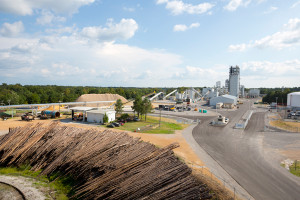Mississippi rolls dice on green energy with taxpayer money

By Steve Wilson | Mississippi Watchdog
Companies have placed high-risk wagers with Mississippi tax dollars on green energy. Now, those bets are coming due.
FROM TREES TO FUEL: KiOR’s Columbus, Mississippi plant is designed to turn biomass into gasoline and diesel fuel. PHOTO BY: KiOR
Two examples of the risks of taxpayer-funded green energy projects in the Magnolia State were both approved by former Gov. Haley Barbour.
Mississippi’s KiOR facility — built with an investment of $75 million by taxpayers — is idled with its owners in serious financial jeopardy. The company said last week in a filing with the SEC it has doubts about its ability to secure more investment to fund its operations and “continue as a going concern.”
Twin Creeks solar plant in Senatobia opened in 2011, but closed the next year. The plant, funded partially with a $26 million state loan, was designed to build ultra-thin silicon wafers used in solar panels. It failed after a few months of operations and the company settled a lawsuit last year with the state to pay back the loan.
“When you gamble with other people’s money, that you won’t have to pay it back, you tend to make more wild bets,” said Andrew Morriss, one of the co-authors of the book “The False Promise of Green Energy” and a law professor at the University of Alabama. “That is what is going on in lots of these cases. Capital markets do discipline companies by demanding real business plans. That doesn’t mean no risk, but having one’s own money in the business tends to concentrate the mind.”
Sumesh Arora, vice president of Innovate Mississippi and director of Strategic Biomass Solutions, said KiOR’s problems with its process, which uses a catalytic cracking technology, isn’t unexpected with a first-of-its-kind production facility.
That plant has endured several stoppages, but Arora said the shutdowns are a matter of fine-tuning the process of turning wood chips into hydrocarbons so the facility can meet its production goals safely and effectively. According to KiOR, the plant is designed to produce 13 million gallons of fuel annually, but only produced 894,000 gallons last year.
“When you scale up something 100 times, it might not scale up linearly,” Arora said. “From the standpoint of the new ground being broken, it’s conducting research on a commercial scale. The question becomes, under what timeframe can you monetize the process? You want to prove it can run at a steady state.
Arora cited the oil and gas industry as an example, saying that its tried-and-true processes for turning crude into fuel products took decades to optimize and weren’t perfected until the 1950s.
As for the issue of funding a first-of-its-kind facility, it’s a question even an engineer like Arora has to take into account. While the science might be right, the economic questions must be answered as well.
“Who should fund the research and commercialization of new technologies?” Arora asked. “The question of who should fund advanced research is not an easy one.”
Contact Steve Wilson at swilson@watchdog.org







